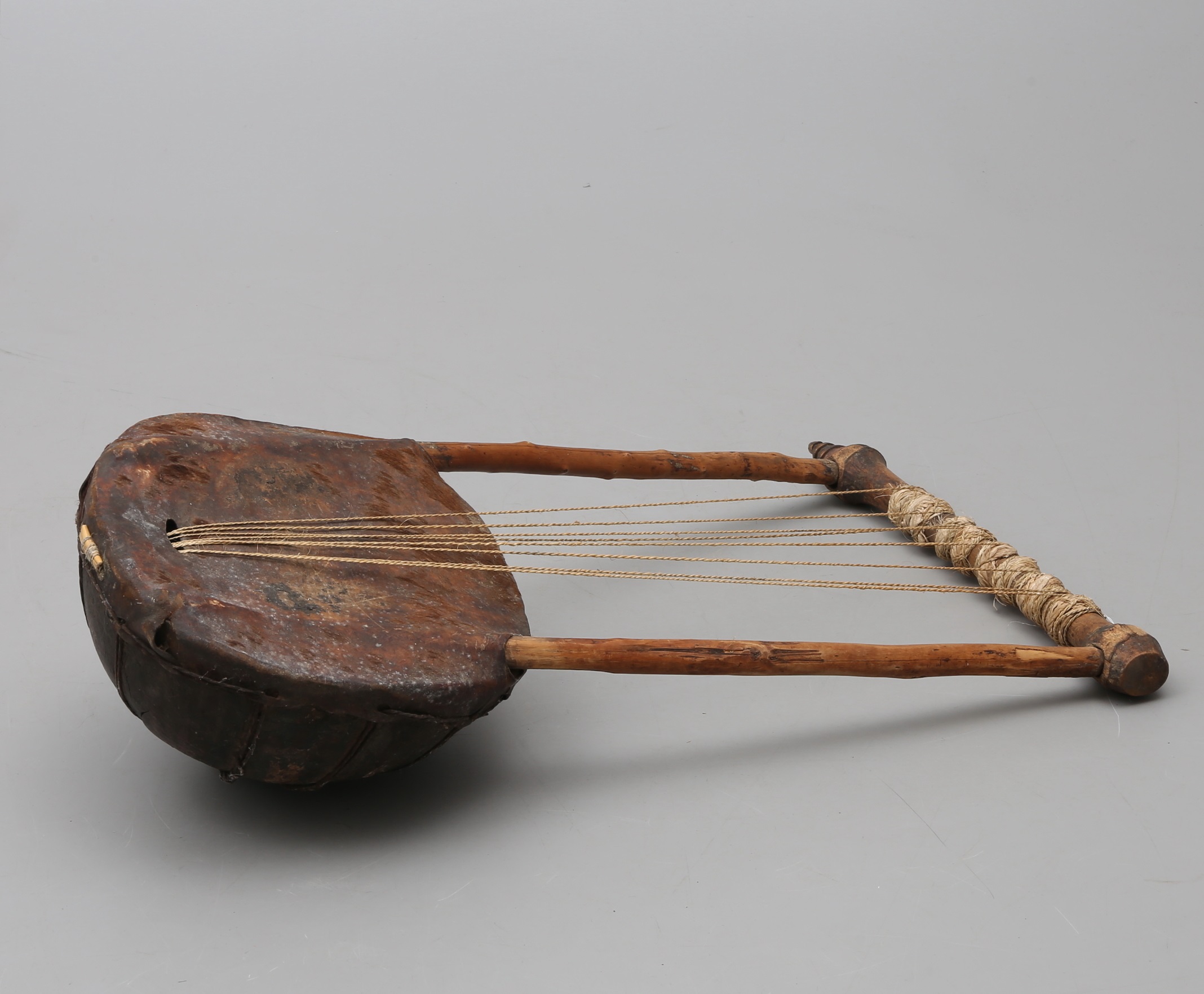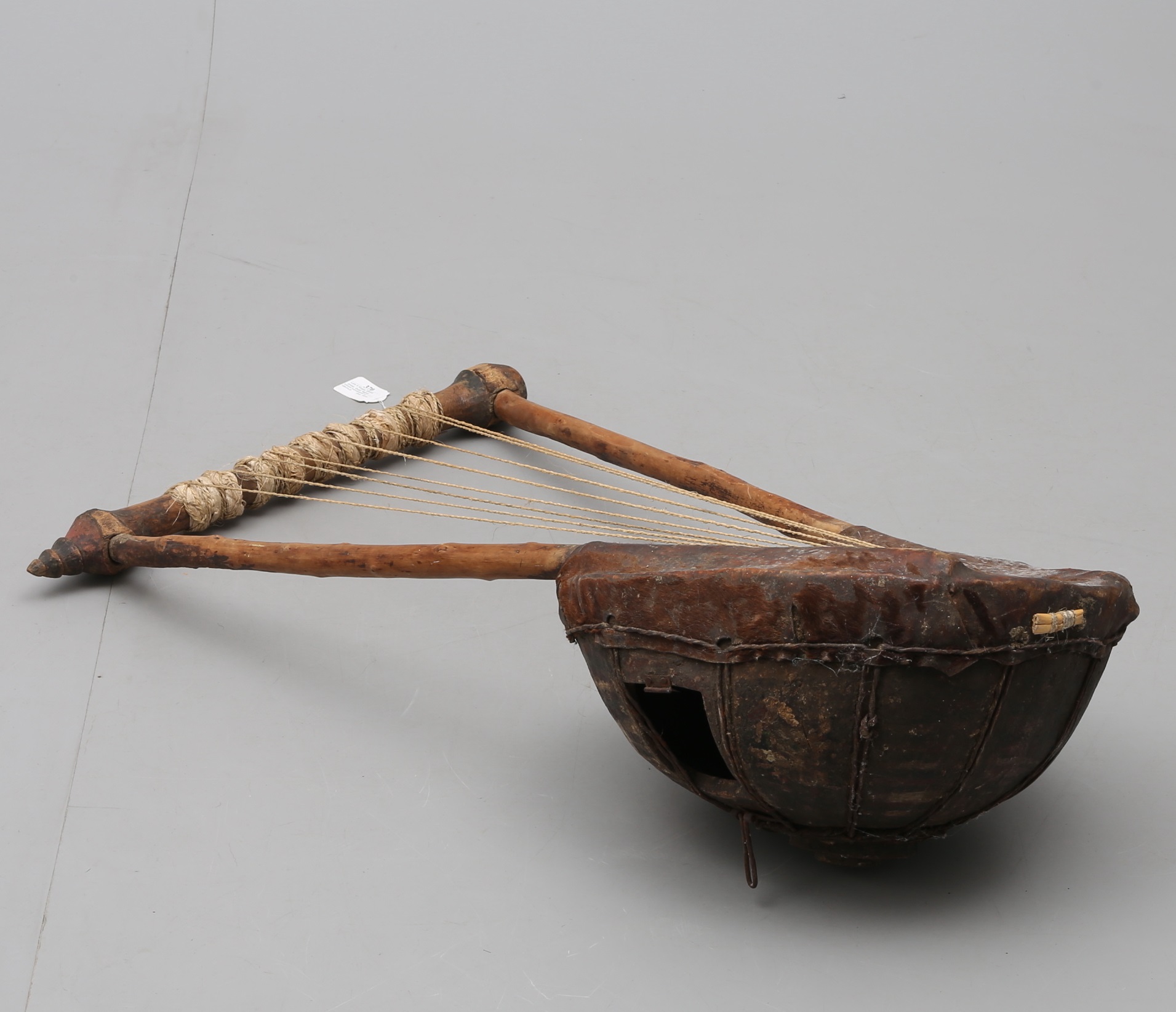Obokano
Plucked Instruments
Africa
Between 1001 and 1900 AD
Video
The Obokano is a traditional East African stringed instrument belonging to the Nyang’ombe lyre family. It is primarily played by the Gusii people of western Kenya. Characterized by its deep, resonant bass tones, the Obokano is known for producing a unique, percussive, and harmonic sound that contributes significantly to the musical traditions of its region. The instrument is large and features a wooden frame with a skin soundboard and gut or wire strings. The sound it produces is often described as both haunting and rhythmic, creating a droning effect that complements the polyphonic singing styles of the Gusii community.
The Obokano is classified as a lyre, which is a subset of the chordophone family. A lyre is a stringed instrument with a yoke, and in this case, the strings are stretched between two arms connected by a crossbar. The Obokano is distinct due to its size and deep-pitched strings, which set it apart from other East African lyres. The instrument functions both as a melody and rhythm provider, serving a role similar to that of a bass guitar in contemporary music settings.
Historical Background
The Obokano originates from Africa, specifically in the Great Lakes region, with a historical presence among the Gusii people of Kenya. It is believed to have existed for several centuries, with records suggesting that it has been played since at least the 18th century, though it likely predates written documentation. The instrument was traditionally used in social gatherings, storytelling, and ceremonial functions, including rites of passage and communal celebrations. Over time, the Obokano has maintained its cultural relevance while adapting to modern contexts, including fusion with contemporary music genres.
Construction and Design
The Obokano is constructed using locally available materials, emphasizing natural resonance and durability. The main components include:
Frame: The body consists of a wooden frame, typically made from a durable hardwood like eucalyptus or fig tree.
Soundboard: Animal skin, often cow or goat hide, is stretched across the frame to create a resonating membrane.
Strings: Traditionally, the strings were made from animal gut, but in modern versions, wire or nylon strings are used.
Bridges: Small wooden pegs or bridges support the strings, ensuring proper tension and spacing.
Tuning Mechanism: The strings are attached to tuning pegs that allow for pitch adjustments by tightening or loosening them.
The instrument is relatively large, with a deep, rounded soundbox that enhances its bass qualities. The playing technique involves plucking and strumming the strings while resting the instrument against the player’s body.
Types of Obokano
While there are no formally recognized subtypes of the Obokano, variations exist based on size, string material, and tuning preferences. Some instruments are crafted for solo performances, while others are designed for ensemble use, influencing the number of strings and the overall tonal quality. Modern versions may incorporate synthetic materials for enhanced durability and sound projection.
Characteristics of the Obokano
The most distinguishing feature of the Obokano is its deep and buzzing bass sound, which gives it a unique presence in African musical ensembles. Unlike other lyres that often emphasize melodic content, the Obokano provides rhythmic and harmonic depth. The buzzing effect is achieved through the bridge design, which allows the strings to slightly rattle against the surface. This characteristic makes it an essential component of Gusii music, as it provides both a percussive and harmonic background. The instrument’s size also makes it distinctive, with players often cradling it against their body while performing.
Playing Techniques and Sound Modifications
Playing the Obokano requires a combination of plucking and strumming techniques. The musician uses both hands, with the fingers plucking the strings in rapid succession to create a continuous and pulsating rhythm. Unlike Western lyres, where individual notes are often emphasized, the Obokano relies on a more fluid technique that blends notes together, producing a drone-like effect. The left hand is responsible for altering the tension of the strings, allowing for microtonal modifications that add expressiveness to the performance.
Sound modifications on the Obokano can be achieved in various ways. Players can adjust the tension of the strings by pressing them against the bridge, changing the pitch slightly. The positioning of the hands can also affect the resonance, with some musicians muting specific strings to create rhythmic variations. The material of the strings also plays a role in sound modification; traditional sinew strings produce a warmer tone, while metal strings create a sharper sound. Some players add additional buzzing elements to the bridge to enhance the characteristic vibration of the instrument.
Applications in Music
The Obokano serves various functions within the Gusii community and beyond:
Traditional Ceremonies: Used in weddings, initiation rites, and funerals.
Storytelling and Oral Tradition: Provides musical accompaniment for narrations and folk tales.
Entertainment: Played in communal gatherings and celebrations.
Modern Fusion: Some contemporary musicians incorporate the Obokano into fusion genres, blending traditional sounds with modern instruments.
Most Influential Players
Several musicians have significantly contributed to the recognition and preservation of the Obokano. Among them, traditional Gusii musicians such as Mogaka Ombati and Nyakundi Ong’era have kept the instrument alive in Kenyan cultural performances. In more recent times, artists like Kenge Kenge and Abana Ba Nasery have incorporated the Obokano into world music, bringing its deep, buzzing tones to international audiences. These musicians have played a crucial role in ensuring that the Obokano is not just a relic of the past but continues to evolve and inspire new generations.
Maintenance and Care
Proper maintenance of the Obokano is crucial to preserving its sound quality and longevity. The wooden frame should be kept in a dry environment to prevent warping or cracking. The animal hide covering needs regular conditioning to maintain its elasticity and resonance. If the hide becomes too dry, applying natural oils can help restore its flexibility. The strings, whether made of sinew or metal, should be checked for tension and replaced when necessary to maintain the instrument’s tonal integrity. Additionally, the bridge should be examined regularly to ensure that the buzzing effect remains consistent. Musicians often wrap the tuning pegs with cloth to prevent slippage and maintain tuning stability.
Advantages and Disadvantages
The Obokano offers several advantages, including its deep, resonant sound that provides a strong rhythmic foundation. It is a highly expressive instrument, capable of producing a range of tones through playing techniques and sound modifications. Additionally, its cultural significance makes it an important tool for preserving Gusii traditions. However, the Obokano also has some challenges. Its large size makes it less portable than other traditional instruments, and its unique playing technique requires specialized skills that are not easily learned. Furthermore, maintaining the instrument can be labor-intensive, especially when using traditional materials that require regular upkeep.
Cultural Significance
The Obokano holds deep cultural significance within the Gusii community. It is not just a musical instrument but a symbol of heritage, storytelling, and social unity. It has been used in rites of passage, such as initiation ceremonies, where its music accompanies traditional dances. The instrument also plays a role in communal events, reinforcing social bonds through music and dance. Additionally, the Obokano has been an essential tool for oral history, with musicians using it to narrate stories of the past, ensuring the transmission of cultural knowledge across generations. Despite modernization, the instrument remains a powerful cultural emblem, representing the resilience of Gusii traditions.
It is more than just a musical instrument; it is a symbol of cultural identity, history, and artistic expression among the Gusii people. Its deep, buzzing tones, intricate playing techniques, and rich cultural significance make it a fascinating subject of study and appreciation. While modernization has influenced traditional music, the Obokano remains an essential part of Kenyan musical heritage, continuing to inspire musicians both locally and internationally. By preserving and promoting the instrument, future generations can appreciate and sustain the rich traditions it represents.
FAQ
What is the origin of the Obokano?
The Obokano is a traditional bass lyre from the Gusii people of Kenya. It has been played for generations in social gatherings and ceremonies. The instrument is deeply rooted in Gusii culture, often used to accompany storytelling and dance. Its resonant, deep tones make it a unique part of East African musical heritage.
How is the Obokano constructed and what materials are used?
The Obokano consists of a wooden frame, often made from fig tree wood, with a resonator covered in cowhide. It features eight heavy-gauge strings stretched over a bridge, producing deep, buzzing tones. The instrument’s construction emphasizes durability and resonance, making it a powerful bass accompaniment.
What is the playing technique of the Obokano?
The Obokano is played by plucking its thick metal strings with the fingers while resting it on the lap or against the body. Players use both hands, alternating between rhythmic patterns and bass drones. The buzzing sound is enhanced by the cowhide-covered resonator, creating a rich, percussive effect in performances.
 Links
Links
References
- Kenya 'Obokano' - Hartenberger World Musical Instrument Collection
- Asuga - Obokano - Jamhuri Day 2022 Lyres Production - YouTube
- KENYA : L’OBOKANO LYRE DES GUSII/ THE OBOKANO LYRE OF THE GUSII
- Obokano: Instrument only played by men - The Standard
- The Obokano of the Gusii: A Bowl Lyre of East Africa - jstor
- Obokano - Gusii instrument. - YouTube
Other Instrument
Categories



















